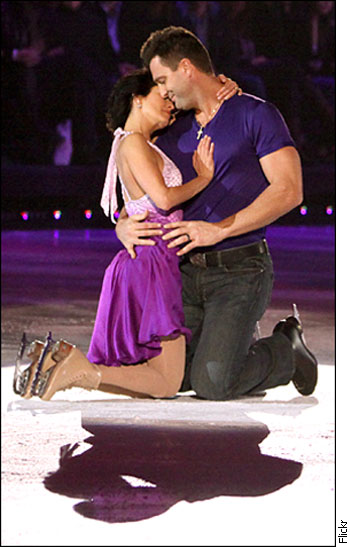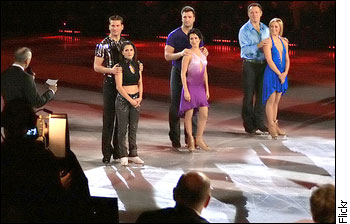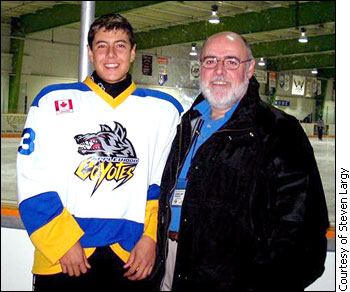Tags
Related Posts
Share This
CBC scores, with Battle of the Blades
The TV screen shows the lights lower in the Maple Leaf Gardens.
Two male skaters dressed in tuxes emerge onto the ice. They skate circles around each other in front of a cheering crowd. The camera cuts to a close-up of the performers’ feet as they stop in unison — one is wearing hockey skates, the other, figure skates. Hosts Ron MacLean and Kurt Browning know how to get the crowd going.

Battle of the Blades pairs retired NHL greats with sweetheart championship figure skaters (here, Marie-France Dubreuil and Stéphane Richer), to create a truly Canadian reality show.
And so it begins.
Battle of the Blades, Canada’s latest attempt at reality-show success, takes hockey tough guys, pairs them with figure skating sweethearts and has them churn out weekly ice dance routines on live television.
The eight couples are judged after each Sunday night performance show using traditional figure-skating scoring by former skating champions and choreographers — with a little help from legendary Canadians like Lanny McDonald and Don Cherry. Viewers cast votes for their favourite couples, and on Monday nights one pair is eliminated from the show.
The simplicity of the concept is almost laughable.
There’s no way people will watch this, right? Imagine hockey fans calling the guys over for a game night that involves pizza, beer and Claude Lemieux in tight pants. Or lifelong figure skating devotees envying the grace and style of an aging hockey player’s death spiral.
Well, judging by the ratings, it isn’t that unrealistic. An average of 1.5 million viewers tune in to the show weekly. So what is it about this show that has Canucks glued to their television screens week after week?
It’s all in our image
The show is quintessentially Canadian, and we can’t get enough.
“It fits with the image of Canada which is all about hockey, figure skating, Tim Hortons, kids skating on a frozen pond in the winter, Ron MacLean’s terrible puns, and Stephen Harper wearing a sweater,” says John Doyle, television critic for the Globe and Mail.
The show has nation-wide appeal because it hits on elements of Canadian culture that everyone can identify with, he says.
Millions of Canadians have connections to hockey and figure skating in one way or another. And in a star system that has more sports figures than actors, the mass appeal is obvious.
“Before it premiered, I said I’d eat my skates if Canadians didn’t eat up a hockey and figure skating competition reality show,” says Diane Wild, contributor to the blog TV Eh?, an information portal for Canadian television shows.
Wild describes Battle of the Blades as being the perfect fit of audience and content. There is just something fun about seeing the worlds of hockey and figure skating collide, she says.

Host Ron MacLean prepares to eliminate one pair on the Blades finale. Salé and Simpson (in black) eventually came out on top.
The Canadiana concept certainly draws in the audiences, but to keep them there, the show needs to entertain, says Denis McGrath, a television writer who has written episodes for Canadian shows like The Border and Rent-A-Goalie. He says Canadian television is often guilty of preaching to its audience.
“You mix in the familiar reality competition format which we’re all used to by now, and figure skating. And then you add the surprising — how will these hockey players and figure skaters mix and work together?” he says.
This combination is undeniably entertaining. You see retired tough guys wearing flashy costumes, and figure-skating champs putting faith in their partners as they seemingly fly through the air during lifts.
“It has flashy lights and sequins but it’s not slick,” says Wild. “You can tell it’s live, which adds excitement.”
And the water cooler factor has new viewers tuning in each week. People are talking about it, says Wild, and the fact that both sports and entertainment reporters are covering it helps its cause.
‘It is a hell of a competition. It makes me proud to be Canadian.’ —fan Stephen Largy
The production values behind Battle of the Blades also give it an edge up on past Canadian reality shows. It reads like a mix between Hockey Night in Canada — which has been fine-tuned for years in this country — and a traditional, competition-style reality show. The graphics are good, the segments are well thought out and the accompanying music pulls the entire show together.
“Watch Battle of the Blades and you’re seeing something that’s been cast, pored over, tightly edited and executed,” says McGrath. While you might see the occasional technical glitch, he adds, the show is well produced and exciting to watch, even for those Canadians who would typically consider reality television to be “the ultimate in crap.”
Converting unlikely fans
Take Stephen Largy for example. He isn’t your typical reality-television fan. He manages a group that finds employment opportunities for people with disabilities, is active as a volunteer in his community and describes most Canadian television as “subsidized mediocrity.”

Blades enthusiast Stephen Largy, with son Edward.
But when it comes to Battle of the Blades and all of the glitter and glam that comes with it, Largy is hooked.
“The absolute last thing on my list of things to do is planning to sit down in front of the television,” he says. “But for this, if we aren’t in front of the television we are recording it. This is straight-out fun!”
What is the appeal for Largy and his family? He managed his son’s hockey team, his wife is a certified ballerina, his family watches figure skating and he loves the ice.
It was all of these factors that had Largy and his family sitting down in front of their television to watch the October premiere. After the first performance show, Largy says they thought it was fun. After the second, they were impressed with the effort being put forth by the hockey players. And by the third, they were die-hard fans. “It is dynamite,” says Largy with enthusiasm. “It makes me proud to be Canadian.”
He says Battle of the Blades is the best thing CBC has done in 25 years. He is looking forward to a second season, which has already been ordered by the network, but he wonders if producers will be able to top the first.
Still, Largy doesn’t classify the show as reality television. “This is a competition. And it is a hell of a competition.”
Tomorrow, the world?
In the November season finale, retired NHL great and current Hockey Night in Canada commentator Craig Simpson and his champion figure skating partner, Jamie Salé, were crowned the winners of the first season. The pair scored $100,000 for their charity of choice: the Spinal Cord Injury Treatment Centre in northern Alberta. Even the losing participants earned $25,000 for their charities.
Executive producer John Brunton is pleased with the success of Battle and says the show has already been sold to Russia, Scandinavia and other emerging figure skating and hockey territories.
“It was one of the highest rated shows CBC has ever had, so we know we got part of it right,” says Brunton. “Now we are looking towards the future, and figuring out ways to keep the audience on the edge of their seats.”
Regardless of who won or lost, Battle of the Blades has successfully tapped into the Canadian soul to produce a show that could make even the most uptight culture snob feel a hint of patriotism.
Related Links
Battle of the reality shows
Battle of the Blades isn’t Canada’s first attempt at a nationwide reality show. CTV led the way in 2003 with Canadian Idol and had six decent seasons. Compare the two shows side by side, however, and Battle has the edge. Battle has better production values; the entertainment factor is undeniable; and the nostalgia it elicits from the audience gives it much more depth than Idol. But what differentiates the two shows the most is that Idol doesn’t tap into a uniquely Canadian obsession as Battle does, an element which will be sure to give the skating show lasting appeal.
|
Battle of the Blades |
Canadian Idol |
|
Features prominent Canadians the audience knows and relates to |
|
|
Kurt Browning, George Stroumboulopoulos, Don Cherry, Ron MacLean |
Ben Mulroney, Sass Jordan, and Farley – who? |
|
Familiar but exciting production style |
|
|
Merges the flashy style of So You Think You Can Dance Canada with the classic Hockey Night in Canada format |
Carbon copy of American Idol: the exact same format, but poor production values leave TV audiences unsatisfied |
|
Caters to a national interest |
|
|
Hockey! Figure skating! Both epitomize the Canadian lifestyle |
People love to sing and listen to great music, but it doesn’t distinguish us as a country |
|
Appeals to a wide audience |
|
|
Hockey and figure skating fans both young and old can appreciate this show |
Young and old people watch the show, but Battle relates better to families' pastimes |
|
Host’s Appeal |
|
|
Kurt Browning is the Canadian equivalent of the all-American charming guy, and you can’t help but laugh at Ron MacLean and his endless puns |
His hair, his jokes, his degree of charisma. Ben Mulroney just doesn’t have the same appeal as American Idol’s Ryan Seacrest |





